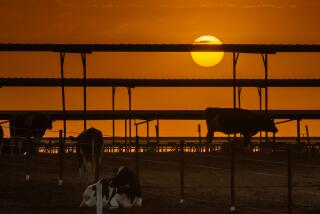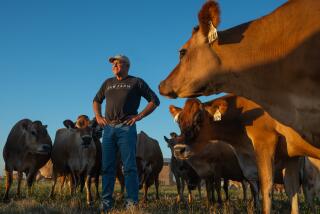Possible Case of Mad Cow Needs More Testing, U.S. Says
- Share via
WASHINGTON — A cow that died of complications from calving in April may have been infected with mad cow disease, the Department of Agriculture said Wednesday.
The animal posed no danger to the human or animal food supply because it was destroyed where it died after tissue samples were taken, said Dr. John Clifford, the department’s chief veterinarian.
Clifford said a sample of brain tissue was submitted by a veterinarian who treated animals in “a remote area,” which he did not identify. The tissue was treated with a preservative and frozen before it was sent in for analysis.
The presence of the preservative meant that only one type of test could be done, Clifford said, and the results were inconclusive.
Additional samples from the same cow are being tested at the USDA laboratory in Ames, Iowa, and at a laboratory in Weybridge, England, that is considered the most sophisticated in the world in identifying the illness. The results of those tests are expected next week.
USDA rules in place in April allowed the use of preservatives, but have since been changed, Clifford said.
Mad cow disease -- formally known as bovine spongiform encephalopathy, or BSE -- is spread when cows eat brain or nerve parts from an infected animal.
Until 1997, when both the United States and Canada banned the practice, the remains of ruminants, or cud-chewing animals, could be ground up and used in cattle feed.
Clifford noted that the animal in question was “well over 12 years old,” meaning that it could have eaten contaminated feed. The farm where the cow lived has not been quarantined, he said.
So far, two cases of BSE have been identified in the United States -- one in Washington state in December 2003, in a cow imported from Canada, and one last month in a cow from Texas.
In the current case, the time lag between the animal’s death in April and its testing in July was “not optimal,” Clifford said. “The sample was not submitted to us until last week because the veterinarian set aside the sample after preserving it and simply forgot to send it in.”
He said veterinarians who traveled to remote areas frequently submitted samples for testing as an extension of the department’s enhanced BSE surveillance program.
Dean Cliver, a professor of food safety at UC Davis, said it was surprising that a cow that died from calving would be tested because it was a common way for cows to die.
The USDA tests samples from all “downer” cows, those unable to walk when taken to slaughter. Cows that die in other ways can be tested, but it is not always done.
But Jim Rogers, a USDA spokesman, said the cow was considered a “downer” cow because it died while calving, so “it fit our profile” of an at-risk animal.
Mad cow is associated with a brain-wasting disorder in humans called variant Creutzfeldt-Jakob disease, which killed more than 100 people in Britain after an epidemic of mad cow disease in the late 1980s and early 1990s.
The inconclusive test comes at a precarious moment for U.S. beef ranchers, who had hoped to resume sales to Japan, once the largest export market for U.S. beef. Sales dried up after the case in Washington state was discovered.
“I would hope it will have no impact on our negotiations,” Clifford said.
Japan has had 20 cases of mad cow disease and tests every animal slaughtered. Authorities there have demanded that the United States test more animals before beef exports can resume.
More to Read
Sign up for Essential California
The most important California stories and recommendations in your inbox every morning.
You may occasionally receive promotional content from the Los Angeles Times.










